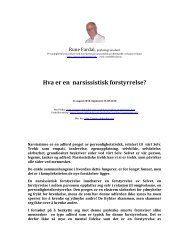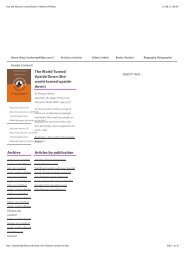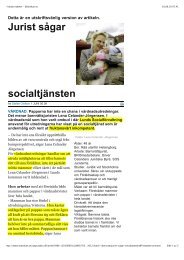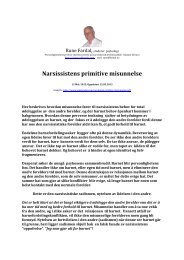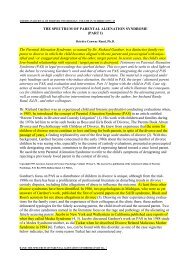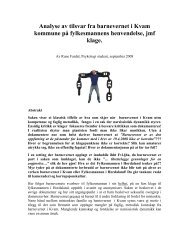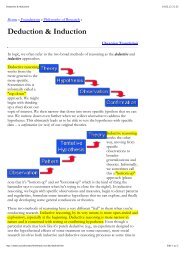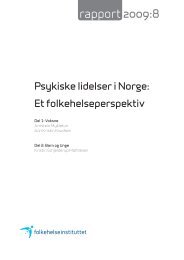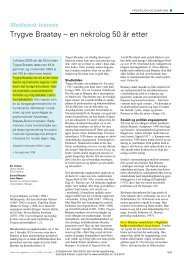The origins of narcissism and narcissistic personality disorder a
The origins of narcissism and narcissistic personality disorder a
The origins of narcissism and narcissistic personality disorder a
You also want an ePaper? Increase the reach of your titles
YUMPU automatically turns print PDFs into web optimized ePapers that Google loves.
THE ORIGINS OF NARCISSISM 59<br />
affairs is that positions about infancy are staked out on the basis <strong>of</strong><br />
uncontrolled case reports <strong>of</strong> analyses, <strong>of</strong>ten <strong>of</strong> adults, without reference<br />
to the growing body <strong>of</strong> developmental research. For example, as regards<br />
the seemingly interminable controversy about whether, as egopsychological<br />
theorists maintain, there is a primary indifference to objects<br />
or, instead, as Fairbairn (1952, p. 137) has written, “the libido is<br />
. . . object-seeking,” the findings <strong>of</strong> attachment researchers, with both<br />
humans (Ainsworth et al., 1978) <strong>and</strong> infrahuman primates (Harlow,<br />
1958), clearly favor the object-relational position. It would seem safe<br />
to conclude, as does Bowlby (1973, 1980, 1982), that infants are born<br />
with powerful drives for attachment.<br />
Despite, however, the seemingly irreconcilable disputes between ego<br />
psychology <strong>and</strong> object-relations theory, both schools have constructed<br />
their ideas about infancy around prenatal metaphors, as if the human<br />
baby, unlike the <strong>of</strong>fspring <strong>of</strong> other organisms, must be born twice. For<br />
ego psychology, the root metaphor is the primary autism <strong>of</strong> the bird<br />
embryo inside its shell (Freud, 191 1/1958a). For object-relations theory,<br />
the organizing image is the primary relatedness <strong>of</strong> the fetus that,<br />
in its amniotic world, cannot be differentiated from the placenta (Balint,<br />
1959). <strong>The</strong>ories about a drive to recover a prenatal state <strong>and</strong> claims<br />
that intrauterine life is without tensions are empirically untestable,<br />
although current empirical evidence, to be reviewed shortly, that infants<br />
seek stimulation, not tension reduction, indicates that these ideas<br />
are highly dubious. Findings (DeCasper & Spence, 1986) that infants<br />
can recognize-that is, have memory for-certain extrauterine events<br />
that occurred during the last trimester <strong>of</strong> pregnancy are also highly<br />
damaging to such claims. It is likely therefore that neither <strong>of</strong> the two<br />
prenatal images accurately characterizes the psychological stage <strong>of</strong> the<br />
human organism prior to birth.<br />
Narcissism <strong>and</strong> the Second Year <strong>of</strong> Life<br />
In addition, one might note that, although all <strong>of</strong> the theorists reviewed<br />
here have described the first year <strong>of</strong> life in a manner quite at odds with<br />
the conclusions <strong>of</strong> infancy research, the comments <strong>of</strong> these writers<br />
about life’s second year are both more illuminating about the <strong>origins</strong><br />
<strong>of</strong> normal <strong>and</strong> pathological <strong>narcissism</strong> <strong>and</strong> more consistent with research<br />
findings in developmental psychology <strong>and</strong> social cognition. For<br />
coincident with the emergence, during the second year <strong>of</strong> life, <strong>of</strong> sym-




